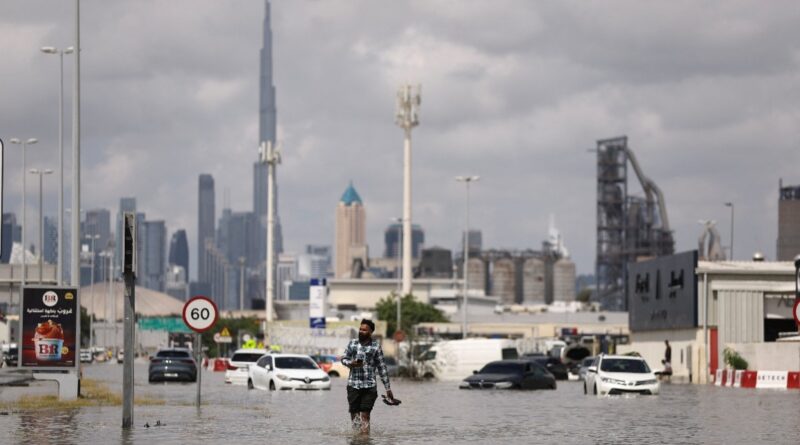Dubai continues to reel from ‘historic weather event’ after heaviest rainfall in 75 years floods city
Dramatic storm causes some to question UAE’s ‘cloud-seeding’ operations

A person walks in flood water caused by heavy rains, with the Burj Khalifa tower visible in the background, in Dubai, United Arab Emirates, April 17, 2024 (Photo: REUTERS/Amr Alfiky).
After an unusually strong storm battered the United Arab Emirates on Tuesday, major cities continued to report disruptions on Thursday morning.
Dubai International Airport announced it had resumed some operations, however, it continued to warn of flight delays.
Flights at the airport were canceled on Tuesday as the storm hit, and they remained canceled Wednesday, due to significant flooding and the interruption of utility services.
Only Thursday morning did some airlines begin to announce a resumption of services.
Airport officials recommended that travelers with itineraries to or from Dubai contact the airlines to confirm service.
There were also several road closures still in place as of Thursday morning across Dubai.
On Tuesday, the United Arab Emirates experienced the largest amount of rainfall since meteorological records have been kept in the country, starting in 1949.
The flooding took out power and water in many areas and caused untold damage to cars, homes, and businesses, as many structures in the desert country were not designed to handle such a large rainfall.
Residents and visitors to Dubai flooded social media with pictures and videos showing the unprecedented flooding caused by the deluge.
One resident told Al Arabiya, “This unprecedented event has left long-term residents like myself, who have called Dubai home for 24 years, shocked and concerned. Never before have we witnessed such severe flooding and rainfall in this city.”
According to authorities, 100 millimeters (almost 4 inches) of rain fell in only 12 hours on Tuesday. That is close to the average annual rainfall for Dubai. As a result, the significant amounts of rain overwhelmed the city’s modest capacity to deal with precipitation. Most roads and urban areas have little drainage systems due to the lack of regular rainfall.
Neighboring Abu Dhabi saw 254 millimeters (10 inches) of rainfall, which was the most recorded anywhere in the UAE on Tuesday.
The Dubai Mall, one of the largest shopping centers in the world, experienced flooding of some shops and parking garages. Videos on social media showed water inside the mall, and there were reports of some windows breaking due to the stormy weather.
Many people questioned the United Arab Emirates’ use of cloud-seeding technology after the record rainfall. However, meteorologists in several countries reported that cloud seeding would not be able to produce such a large downpour.
Professor Suzanne Gray, from the University of Reading, contested accusations of cloud-seeding causing the flooding.
According to her, “Satellite imagery suggests the flooding and rainstorms Dubai were caused by something called a mesoscale convective system. Mesoscale convective systems are what we get when lots of individual thunderstorms amalgamate to form a single, large high-level cloud shield, typically hundreds of kilometers across, together with a large region of heavy rainfall.”
She pointed to historical data showing that such systems have been recorded in the March-April period before, although not with such dramatic levels of rainfall.


